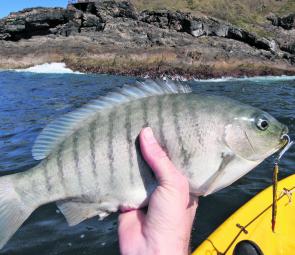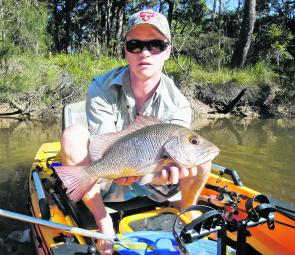Coffs Harbour, lying on the fabled 30° South Latitude line, has been labelled by the CSIRO as having the best climate in Australia. It has also been internationally awarded as the most liveable city in the world. Not too hot, but not too cold. Not too crowded, but plenty of services and amenities.
Coffs Harbour has a lot to offer both the permanent resident and the first-time visitor, and when comes to fishing the region more than lives up to the claim of having ‘the best of both worlds’. It lies at the perfect latitude where you can fish for tropical and temperate water fish. Offshore this is especially true, and Glen Booth covers this in the offshore portion of this Coffs Harbour feature.
On land the Coffs region still holds true to that notion of perfect mix of hot and cold. In this article I will shine a spotlight only on fishing the harbour itself and its immediate surroundings, but this small area still accurately illustrates what the Coffs region is like as a whole. The best word to describe this area is ‘diverse’, with lots of options for every form of fishing. Coffs Harbour has a place and target species for anyone, whether you like fishing from beaches, rock walls, estuaries or rocky headlands. For visitors and locals wanting to get out and wet a line, here is a rundown of the main options you have around Coffs Harbour.
To our eyes the jetty is the most prominent feature of the harbour itself and is an iconic landmark for the city. Although it tends to be one of the most obvious fishing locations visitors gravitate towards, it is often not the best option.
The jetty does have a small lower deck closer to the water but it isn’t very large and offers little protection from the wind in any direction. There can be good bream, trevally and whiting around the pylons but they can be hard to extract from the barnacle and worm-encrusted structure. At night anglers do catch the odd kingfish and mulloway but they can be very hard to land with the height of the jetty.
The area surrounding the jetty is flat and sandy without much structure at all. This means that somewhere like the marina, with its ample structure, tends to attract more marine life.
When the rivers are muddy brown with rain and the seas way too rough for rock fishing, the marina can be one of the only options. It can be a surprisingly rewarding place to fish though, even on fair weather days.
The marina is on the northern side of the harbour and almost anything is hookable, but with the pontoons, boats and rock walls providing so much structure not everything will be landable.
Fishing from the wharf beside the fishing co-op is an easy spot for the family. You can park the car right there, and there’s good access to the waterfront. This is a great spot for the kids to chase bream, whiting, flathead, trevally and tailor on bait like prawns or pilchards. Some of the trevally in the marina can get quite large so landing some of these fish may be troublesome, but it’s still a very fun activity for the family.
Those who prefer lures can throw soft plastics, hardbodies or even flies chasing the fish hanging out around the structure. There are plenty of spots to poke a lure into but be aware that not all areas of the marina are open to public access.
One of the great aspects of fishing in the Coffs Harbour Marina is that you never know what you will get. One day it will be flathead and whiting, the next fingermark and sweetlip. One of my first experiences with the Marina was walking along one of the boardwalks and watching a pack of 1m+ cobia patrolling around the docked boats. Big kingies, good size jacks and giant trevally won’t show up on every trip, but these big fish certainly can be targeted and landed in the marina.
The north wall connects Muttonbird Island to the mainland and runs along the ocean side of the marina. The north wall has easy access and parking and there are several good platforms for fishing.
The better fishing is found once you’re out past the ‘north wall reef’, a permanently exposed bommie around halfway along the wall. Good schools of luderick can be seen out towards the Muttonbird Island end, and tailor and salmon schools are common in the middle of the year. The north wall can be sheltered in southerly conditions but be aware that waves do break over the entire wall and into the marina in large seas.
The first thing you will notice about the south wall if you visit in the next few months is that there is a giant resident crane and huge trucks lugging enormous concrete blocks back and forth on the wall. The south wall is currently being upgraded and so is inaccessible by the public for several months, but I’ll still give you a rundown of south wall fishing for those wanting to visit in the future. Obviously the fishing spots and platforms will be different after the upgrade, so before you set up please assess carefully whether it is safe to fish your intended spot.
The harbour side of the wall is shallow and sandy and the fishing there usually isn’t great, although it can hold good whiting. The ocean side of the wall is much deeper than the north wall with more structure on the bottom and nearby reef. The south wall can attract very good fish and you can expect to regularly catch tailor, mulloway, kingfish, trevally and snapper. The north wall has some of the best ocean luderick spots in the area and the end of the wall is a well known spot for land-based mackerel and tuna.
Although the upgrade may make it safer, remember that waves can break over the entire wall in rough seas and more than a few people have been injured when washed off the south wall.
Inside the harbour is a very protected beach that doesn’t get a lot of large wave action. Jetty Beach can be a great relaxing beach fishing location by yourself or for the whole family. Rips, sand banks and gutter formations are usually not very pronounced, other than two permanent rips at either end of the beach next to the walls. Even without this structure the jetty beach can hold good fish.
Jetty Beach also provides a great sheltered beach worming spot, and with fresh worm baits you can get great bream and whiting as well as the odd mulloway. Jetty Beach also provides calmer water access to salmon schools in the winter.
The harbour side of Muttonbird Island has some good fishing platforms when the weather and seas prevent safe fishing out the front. Be wary of large sets rolling into the harbour in rough weather though. There is good structure under the washes and tailor, mulloway, trevally and large bream are regular catches.
It is a fair hike up over the hill to the front side of the island but the fishing can be VERY rewarding. Here the rock platform drops very steeply and provides great land-based access to deep water with a good tide line usually heading from the wash out to sea. This forms part of the regular patrol route for many offshore predators. Drifting a live bait off the front of Muttonbird could net you good kingfish, cobia, mackerel, longtail tuna and has even accounted for the odd marlin.
Snapper, mulloway, trevally and jumbo tailor are also common catches on both bait and lures. The northern side of the island has a fair bit of reef but is shallower than the front side. Lots of kelp can make it hard to fish bottom baits as you get closer to the marina end.
In a southerly wind and swell this can be a very protected part of the coast and so can become one of the only options for rock fishing. These kelp beds are one of the few spots locally that you can really target squid although success is still far from guaranteed.
Entering the ocean at the northern end of North Wall Beach, Coffs Creek is an often underestimated estuary conveniently located in the middle of town. The lower estuary fishes well for bream, flathead and whiting and is dominated by channels, weed beds and sand banks. The upper estuary is dominated by a mangrove lined channel with plenty of snags that hold good trevally, mangrove jack and mulloway.
There is a boardwalk/track that runs around the entire estuary providing super easy access to many points around the creek. There is the possibility of bass higher upstream but there are many better options in the region which I’ll mention later on.
The south wall joins onto Corambirra Point but most locals refer to the ocean side of this headland as Gallows, the local name for the adjoining beach before the start of Boambee Beach. Access may be restricted slightly during the wall upgrade but you can walk over the top of the headland and around the quarry to access the front of the headland, which has fishing similar to the south wall. The southern side of the headland provides good mulloway and tailor as well as salmon in the winter.
Gallows can be very rough in a southerly swell but it’s a good spot out of the wind in the prevailing summer nor’easters.
Boambee Beach is accessed from the southern end of the harbour by driving around the front of the deep sea fishing club. No permit is needed to drive onto the beach but be aware that there can be deep sand at the entry of the beach.
Boambee beach is a great worming beach and with gutters and sand bank structures along the entire beach there is plenty of space to fish away from others. Mulloway, bream, whiting, salmon and tailor are all potential targets and common catches.
As I mentioned at the start of this article, the harbour area is just a glimpse at the overall diversity of the entire region. There are many other options in the area if you want to get out of town and explore the Coffs Coast.
Bonville and Boambee Creeks to the south have good access to land-based, kayak and boat fishing. All local estuaries fish well for the standard bream, whiting and flathead as well as holding good populations of trevally, mangrove jacks and school jew.
All rivers and creeks in the area have healthy populations of bass in the freshwater stretches. Some areas are difficult to access but they’re worth it if you can find your way in. Others such as the Bellingen and Orara rivers have many access points and are renowned as prolific bass destinations. The Orara river to the west of Coffs is unique in that it’s one of the only rivers east of the divide that starts closer to the coast than where it finishes. The head waters of the Orara are just behind Coffs Harbour and only a few kilometers from the ocean. The river empties into the Clarence river around 100km upstream from where the Clarence meets the Pacific Ocean.
A unique feature it shares with the Clarence River is that it is home to the eastern freshwater cod (or Clarence River cod). Native only to the Clarence catchment, these fish were fished very heavily in the past and are now totally protected – not even targeted catch and release is permitted. Clarence cod are a common bycatch though when bass fishing in the catchment. If you accidently catch one while bass fishing, please release it in the healthiest condition possible.
If you head a little further west from these bass creeks and up the hill towards Dorrigo and Ebor, you will find semi-alpine trout streams stocked with brown, rainbow and the odd brook trout. Trout can be caught anywhere from only 45 minutes out of Coffs Harbour. Almost any river or creek past Dorrigo will hold trout and there’s some unbelievably awesome country to throw a fly or lure around.
Pretty much whatever fish you prefer to chase, Coffs Harbour is well worth the visit. There are not many places in the country or even the world where you could potentially catch a mackerel, snapper, mangrove jack, bass and a rainbow trout in the same day. It would be a mega effort in a day but consider it the 30° South challenge! If you’re going to give it a crack, make sure you let me know. It would be an adventure well worth filming, that’s for sure.
Reads: 15228
Excellent bream call the Coffs Marina home. This one was caught on a prawn by Nezzie Gaden.

The harbour is the gateway to the offshore grounds of the Coffs Coast, and the northern corner of Jetty Beach can be a great launching spot for kayakers. The boat ramp is unfortunately the only option for boaties who don't want to beach launch or risk a r

One of the plentiful luderick around the harbour. The rock platform out the front of Muttonbird Island can be seen in the background.

Jacks are at the top of many anglers’ lists when it comes to fishing the Coffs Harbour region.

There is an endless supply of quality bass waters on the Coffs Coast. Awesome fish and awesome locations.

School jew this size are very common on Coffs beaches but there's always the chance of that 20kg+ model that keeps mulloway anglers fishing into the night.

Significant numbers of nice size GTs inhabit the upper estuaries and there is even odd capture of 5-10kg models, especially in the Coffs Harbour marina.

A unique feature of sub-tropical Coffs Harbour is that it's only an hour’s drive to trout country and potential freezing temperatures.

Quality whiting are a feature of the Jetty Beach, the Marina and lower estuaries. Surface lures are definitely the best way to target larger specimens in the estuaries.

Upstream in some of the smaller coastal creeks you can target both bream and bass on cicada lures.

Flathead are a great target for soft plastic fishing in the estuaries but even the sheltered harbour can offer some fun for the lure angler.




